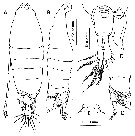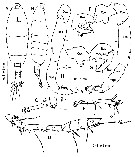|
|
 |
Fiche d'espèce de Copépode |
|
|
Calanoida ( Ordre ) |
|
|
|
Diaptomoidea ( Superfamille ) |
|
|
|
Tortanidae ( Famille ) |
|
|
|
Tortanus ( Genre ) |
|
|
|
Atortus ( Sous-Genre ) |
|
|
| |
Tortanus (Atortus) andamanensis Nishida, Anandavelu & Padmavati, 2015 (F,M) | |
| | | | | | | Ref.: | | | Nishida & al., 2015 (p.218, Descr.F, M, figs.F,M, Rem.); Francis & Bijoy Nandan, 2019 (p.433, Table 4, 5). |  Issued from : S. Nishida, I. Anandavelu & G. Padmavati in Crustacea, 2015, 88 (2). [p.219, Fig.1] . Female (from 11°33'N, 92°43'E): A-B, habitus (dorsal and lateral, respectively); C, genital complex (left lateral); D, pediger 5 and genital complex (ventral); E, P5. Coupming device is dotted in A-C. Nota: Prosome about 3.8 times as long as urosome. - Cephalosome and 1st pediger separate, 4th and 5th pediger fused. - 5th pediger asymmetrical with semicircular dorsolateral processes near posterior margin, right process being produced more posteriorly than left. - Urosome 2-segmented; 2nd urosomite completely coalesced with xaudal rami. - Genital compound somite about as long as wide in dorsal view with right anterolateral margin slightly swollen. Genital operculum semivircular, located ventrally at anterior 1/4 of genital compound somite. - Caudal rami asymmetrical with left ramus slightly produced medially midway and corresponding margin of right ramus slightly concave. - All specimens have transparent coupling device (see Ohtsuka & al., 2000) with right vane larger than left, covering dorsolateral processes of 5th pediger and right lateral surface of genital compound somite. - P5 uniramous, 2-segmented, and symmetrical with coxae and intercoxal sclerite fused as basal plate; ramus roundish rectangular, wit distolateral seta.
|
 Issued from : S. Nishida, I. Anandavelu & G. Padmavati in Crustacea, 2015, 88 (2). [p.220, Fig.2] . Female: A, B, A1 (star indicates segment XXI); C, A2; D, Md (palp); E, Md (gnathobase); F, Mx1; G, Mx2; H, Mxp. Nota: A1 symmetrical, reaching posterior margin of caudal ramus; ancestral segments I-IX, XI-XIV, XXVI-XXVIII totally or partially fused. - A2 coxa without seta; basis and 1st endopodal segment completely fused with medial seta at proximal third, distomedial seta and distolateral row of spinules, 2nd and distal segments incompletdly fused, distal segment with proximolateral tuft of setules and 6 terminal setae; exopod 3-segmented, proximal segment short and unarmed, middle and distal segment incompletely fused, with 3 and 2 setae, respectively (distal segment minute and the suture between two segments not shown. - Md gnathobase with 5 cusped teeth, 2 ventralmost teeth with articulated tip, 2 ventralmost teeth and dorsalmost tooth monocuspidate while remaining 2 teeth bicuspidate, 4 dorsalmost teeth with 4 longitudinal spinule rows proximally; basis elongate and unarmed; endopod 2-segmented, proximal segment unarmed, distal segment with 6 setae; exopod 1-segmented with 5 setae. - Mx1 basis and rami completely absent; praecoxal arthrite with 12 spinulose setae and 1 minute seta; coxal endite with 3 stout, spinulose terminal setae. - Mx2 syncoxal endites with 1, 2, 2 and 3 setae from proximal to distal; basal endite with 1 developed and 2 rudimentary setae; endopod with 5 stout setae with claw-like tip and 2 rudimentary setae. - Mxp syncoxa with 2 endites, each with spinulose seta; basis unarmed; endopod with 3 medial spinulose setae and lateral seta.
|
 Issued from : S. Nishida, I. Anandavelu & G. Padmavati in Crustacea, 2015, 88 (2). [p.221, Fig.3] . Female: A-D, P1 to P4, respectively (anterior view).
|
 Issued from : S. Nishida, I. Anandavelu & G. Padmavati in Crustaceaba, 2015, 88 (2). [p.219, Fig.1] . Female & Male: Armature formula for swimming legs P1 to P4. Outer seta on P1 basis minute. Seta in Arabic numerals, spine in Roman numerals.
|
 Issued from : S. Nishida, I. Anandavelu & G. Padmavati in Crustacea, 2015, 88 (2). [p.222, Fig.4] . Male: A-B, habitus (dorsal and lateral, respectively); C, urosome (right lateral); D-E, A1 (segments XIX and XX are indicated with star); F, P5 (anterior); G, right P5 (posterior); H, left P5 (posterior). Abbreviations: Cox, coxa; Bas, basis; Exp, exopod; Exp1, 1st exopodal segment. Nota: Prosome about 3 times as long as urosome. - Posterior corners of 5th pediger rounded and symmetrical.
- Urosome 5-segmented; proportional lengths of urosomites and caudal ramus 17 : 17 : 14 : 12 : 10 : 30.
- 2nd urosomite with posterolateral and posterolateral processes on right side, of which latter smaller, each with minute seta on tip, and tip of former not reaching end of 2nd somite in dorsal view but reaching in lateral view.- Appendages similar to those of female except right A1 and P5.
- Right A1 geniculate; ancestral segments I-VIII, XXI-XXIII, XXIV-XXVIII totally or partially fused; segments XVI-XIX expanded. Anteroproximal process on segment XIX slender, reaching distal end of segment; serrated ridge on segment XX produced proximally over 1/3 of segment XIX; Anterodistal seta on segment XX slightly curved near base.
- Right P5 coxa semi-trapezoid with semispherical medial process; basis semicircular with seta on posterior surface and large medial process bearing 2 setae, medial process being ocarina-shaped with depression on distomedial margin and with small rounded process at distal side of its base; exopod 1-segmented, slightly curved inwards, tapering distally into narrow tip, and with 4 setae. Left leg coxa unarmed; basis elongate and straight, with lateral seta at distal third and medial seta midway; exopod 2-segmented, proximal segment with distolateral seta and proximomedial, large fingerlike process bearing seta, distal segment with patches of setules on anterior surface, 2 medial setae, 2 lateral minute setae, and blunt distal seta.
|
 Issued from : S.V. Francis & S. Bijoy Nandan in Turkish J. Zool., 2019, 43. [p.434, Table 4]. Differential diagnosis of T. andamanensis female. Compare with other species of the subgenus Atortus species from the Indian Ocean. Morphological characters female: - Genital compound somite asymmetrical, right anterolateral margin slightly swollen.
|
 Issued from : S.V. Francis & S. Bijoy Nandan in Turkish J. Zool., 2019, 43. [p.435, Table 5]. Differential diagnosis of T. andamanensis male. Compare with other species of the subgenus Atortus species from the Indian Ocean. Morphological characters male: - Left P5 with subdistal blunt seta, and right P5 coxa semicircular with the medial process being ocarina-shaped with depression on distomedial margin and with small rounded process at distal side of its base.
| | | | | NZ: | 1 | | |
|
Carte de distribution de Tortanus (Atortus) andamanensis par zones géographiques
|
| | | | | | | Loc: | | | Indian (South Andaman island, Burmanallah)
Type locality: 11°33' N, 92°43' E. | | | | N: | 1 | | | | Lg.: | | | (1180) F: 2-2,23; M: 1,67-1,78; {F: 2,00-2,23; M: 1,67-1,78} | | | | Rem.: | Cette espèce est la dernière prise en compte (16 octobre 2015) dans la base des données sur les copépodes marins pélagiques (largo sensu) des origines jusqu'à cette dernière date pour toutes les mers et océans. Cette ''essai'' de synthèse est en reconnaissance de tous les collègues qui se sont confrontés à ce groupe zoologique, tant des points de vue systématique que biologique. L'idée initiale de ce travail par l'un de nous (C. R.) est dû aux travaux de R. B. Seymour Sewell, Lieutenant-Colonel, IMS (late Director, Zoological Survey of India, Calcutta)
| | | Dernière mise à jour : 11/02/2020 | |
|
|
 Toute utilisation de ce site pour une publication sera mentionnée avec la référence suivante : Toute utilisation de ce site pour une publication sera mentionnée avec la référence suivante :
Razouls C., Desreumaux N., Kouwenberg J. et de Bovée F., 2005-2025. - Biodiversité des Copépodes planctoniques marins (morphologie, répartition géographique et données biologiques). Sorbonne Université, CNRS. Disponible sur http://copepodes.obs-banyuls.fr [Accédé le 25 décembre 2025] © copyright 2005-2025 Sorbonne Université, CNRS
|
|
 |
 |







